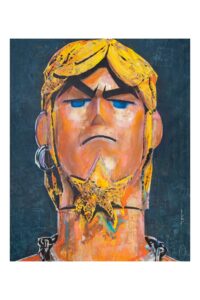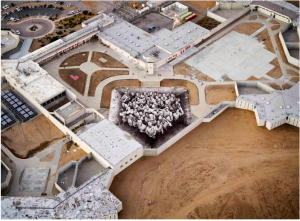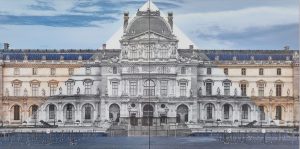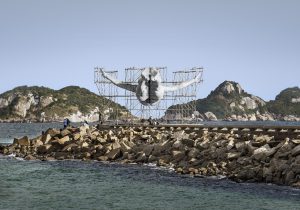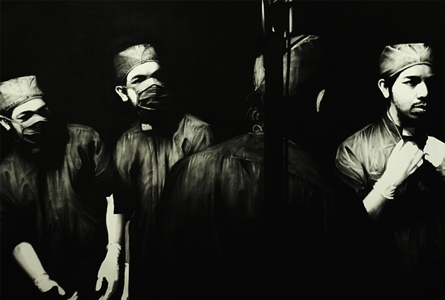
The Four Thinkers” 2012 Charcoal on canvas 300 x 190 cm / 9.8 x 6.2 feet
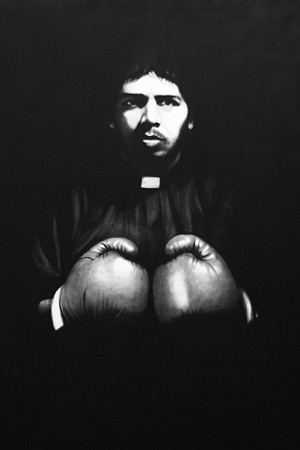
”A Man who lives by prayer” 2012 Charcoal on canvas 150 x 200 cm / 59 inches x 6.6 feet
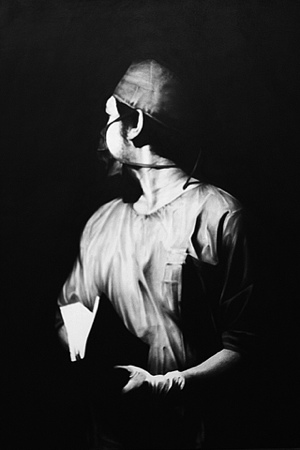
”My Right” 2012 Fusain sur toile / Charcoal on canvas
150 x 200 cm / 59 inches x 6.6 feet
22nd August – 14th September 2012 Galerie Perrotin, Hong Kong
Galerie Perrotin, Hong Kong is to present J.Ariadhitya Pramuhendra’s solo show “Religion of Science”, from August 22nd to September 14th 2012.
Remarkable for his realistic black and white charcoal paintings, J. Ariadhitya Pramuhendra (b. 1984 in Semarang, Indonesia) creates uncanny realistic portraits and theatrical figurative scenes that evoke Christian iconography, surreal science, and the empowering of self. His works question the spiritual validity of authoritative organisational structures such as organised religions and the medical corps in their search for truth and the divine in man. Pramuhendra investigates the question of one’s core identity, expanding from his own traditional catholic upbringing within the context of practicing Christianity in a Muslim country – the largest Muslim country in the world in fact – visually expressing his search through monochrome aesthetics that draw from figural representation, personal and cultural symbolism, tradition, renaissance, and pop art – in opposition to Islamic religious art aniconism.
When Pramuhendra started showing his religious subject in 2006 he was one of the rare to explore the topic, with the consequence of surprising and raising concerns for his choices among his audience. The artist felt strongly about exploring a way to assert who he was, all the while in the process of discovering it and asking the question to himself. His works are about fully assuming a set of beliefs he just started to explore critically.
Departing from the idea that if an artist is to ambitiously tackle core life questions and universal human issues, then he should start from the study of self, Pramuhendra develops series that stage his representation repetitively, as well as his family’s, in various black and white renditions where he is endorsing the role of Jesus Christ, the pope, a minister, a doctor, in a realistic photographic style yet close to a twenty-first century Georges de La Tour or Caravaggio with chiaroscuro renderings and dramatic potency.
By working on self-portraits, Pramuhendra’s practice echoes the long artistic tradition of self-portraiture. Often showing himself in a position of authority, he points at the power of the robe, and appropriates to himself its strengths and weaknesses. By picturing his spirituality through the one religion he is intimate with and immersed in since birth, his ways echo the ambiguous relationships experienced by some contemporary artists such as Gerhard Richter with the Western Church. But by posing himself and his family successively as the Redeemer, a Catholic pope or a nun; and by visually integrating medical imagery, secular postures and profane body languages, Pramuhendra points at the opposition in concepts between criticising and belonging, practicing blindly and consciously approving, trusting religious leadership and finding one’s own answers through a personal connection with the divine. Somehow managing to mix dramatic effect and a touch of humour by gently creating visual oppositions, Pramuhendra raises universal questions: where is sacred within us, is it in our bodies? Does it belong to the religious leaders? Science? Where does the power of God resides?
His works are part of those contemporary art practices that explore religion, and religiosity, by pointing at the political organization that is the church, its leaders, its power struggles, and its acceptance or non-acceptance of others. As opposed to a contemporary political or social critique where the artists are both outsiders and heir of the religious culture they dispute, Pramuhendra’s practice openly claims a heartfelt introspection and a religious devotion, particular to the geopolitics of his Indonesian catholic background. One could think of Francis Bacon’s Screaming Popes series, where Bacon brought forward emotions about his own condition under the pretences of a purple robe, in opposition to how Pramuhendra approaches his spiritual grief and doubt by empowered representations of self, and calm attitudes on canvas, but also how he alternates surrender and expectation.
Pramunhendra’s use of charcoal as a medium is an evolution of his background in printmaking. Through his exHperience of the medium, in conjunction with his subject matter, he developed a visual language and technique compatible with the themes he describes. Drawing is a medium sensitive to the artistic thought process, it both reveals the artist’s intention, and creates an intimate aura for whom experiences the paintings directly. Black and white realism references photography but by creating unreal scenes Pramuhendra’s works emanate an eerie quality, a visual stunt that is hard to replicate. The black of the charcoal, the symbolism of the fire, the burning, the purgatory are not so distant from the way the artist experiences art making, using his fingers, physically engaging with his paintings, taking the time in loneliness to meditatively, layer after layer, create large visual statements, reminiscent of the Shroud of Turin – the black and white ash print of the body of Jesus Christ, believed to be his burial cloth. Enhanced by the charcoal chiaroscuro effect, his images carry extraordinary emotional impact, evoking the monumental & striking drawings by Robert Longo.
There are no simple and quick ways to interpret meanings in Pramuhendra’s works, and there should not be since they are the result of a visceral response to the human condition that the artist interprets through images that contain multiple associations. He gives himself entirely to the canvas, devotedly, using a disarmingly simple and potent visual language that evolved from his research into his own spirituality, literally diving within the notion of identity – but really creating a world for itself, staging the artist as a seer, as a surgeon into the soul, researching the unknown, surrendering to his own power.
